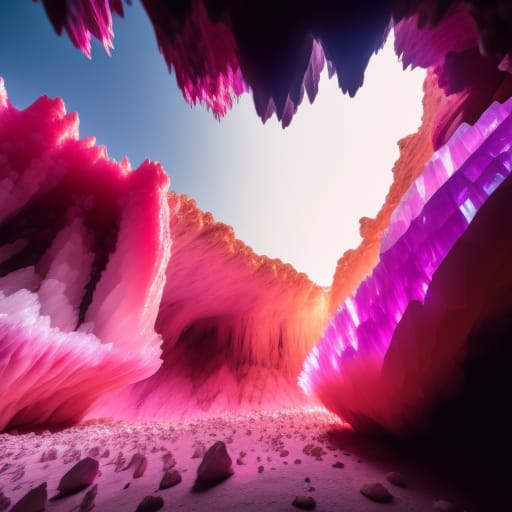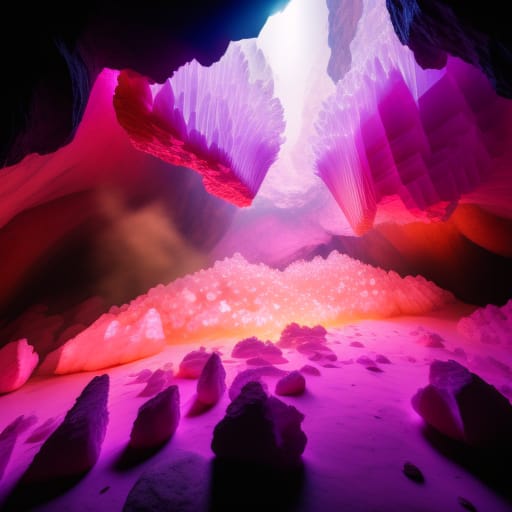Crystal formation is a fascinating natural phenomenon that has intrigued scientists for centuries. This guide will provide an introduction to the basics of how crystals form, grow, and develop their structure.

What is Crystal Formation?
Crystal formation is the process by which a crystalline solid is formed from a solution, melt, vapor, or gas. This occurs through two main steps:
- Nucleation – the initiation of a crystalline phase
- Growth – the development of the crystal structure
Understanding these mechanisms is key to controlling crystal production and engineering materials with desired properties.
The Science of Crystallography
The field of science devoted to studying crystals is known as crystallography. It involves characterizing and analyzing:
- Crystal structures
- Symmetry
- Defects
- Growth patterns
This provides insights into a mineral’s lattice arrangement, molecular bonding, and other physicochemical characteristics.
Some key aspects of crystallography include:
- Crystal systems – there are 7 major geometric systems crystals can form into depending on axes lengths and angles
- Crystal faces – the flat surfaces that form the external shape of a crystal
- Miller indices – a notation system to identify crystal planes and directions
Nucleation: The Origin of Crystals
Nucleation marks the initial formation of an orderly solid phase from a solution or melt. It occurs in two stages:
- Ions, atoms, or molecules begin clustering into small embryonic crystallites
- These reach a critical size and begin growing into larger crystalline particles
Several factors influence the rate and ease of nucleation:
- Supersaturation – a higher concentration of solute promotes nucleation
- Temperature – nucleation is thermodynamically favored at lower temperatures
- Impurities – can provide nucleation sites by disturbing the symmetry of the fluid
There are two types of nucleation:
- Homogeneous – occurs spontaneously within the bulk fluid
- Heterogeneous – triggered by exogenous surfaces or impurities
Crystal Growth Mechanisms
Once the first microscopic crystals have nucleated, further growth occurs by ion/atom/molecule addition. Major mechanisms include:
- Surface integration – direct addition onto existing surfaces
- 2D nucleation – layer-by-layer growth from 2D nucleation sites
- Spiral growth – around dislocations in crystal surface
- Polyhedral skewing – due to differences in growth rates on various faces
The growth rate generally depends on factors like temperature, pressure, solution concentration, and surface kinetics. This determines the final size and habit.

Internal Structure: Lattices and Symmetry
The atoms, ions, or molecules in a crystal are precisely arranged into an orderly 3D lattice. Common types include:
- Cubic
- Hexagonal
- Tetragonal
- Orthorhombic
- Monoclinic
- Triclinic
The geometry of the lattice is defined by:
- Unit cell – smallest repeating unit
- Lattice points – positions of ions/atoms
- Symmetry elements – axes, planes, centers of rotation
Together, these elements create the crystal structure and are responsible for a mineral’s properties.
Crystal Defects
While crystals tend to form perfectly ordered lattices, defects are common. Point, line, and planar defects include:
- Vacancies – missing ions or atoms in the lattice
- Impurity atoms – foreign atoms substituting others
- Dislocations – disruptions in the lattice periodicity
- Grain boundaries – interfaces where crystallites meet
Defect concentration depends on growth kinetics and thermodynamic favorability. Heavily defective crystals can have very different properties than their perfect counterparts.
Phase Transitions and Diagrams
As conditions change, crystals can transition between:
- Solid phases – polymorphic variations in the solid state
- Liquid – melting
- Vapor – sublimation
Phase diagrams map out the equilibrium phases and transitional boundaries between them:
Monitoring phase transitions and boundaries is critical for applications like materials processing and pharmaceuticals.

Kinetic Processes in Crystallization
Beyond thermodynamic equilibrium, many processes impact crystal development through their kinetics:
- Nucleation rate – affects the number of grains
- Growth rate – determines size distribution
- Agglomeration – clusters crystals into larger ones
- Recrystallization – forms new strain-free grains
- Twinning – intergrowth of two crystals
Controlling these kinetic factors is key to tailoring crystal properties. Slower processes like annealing generally produce higher purity and more ordered crystals.
Conclusion
This guide covers the fundamentals of how crystalline solids form and develop their intricate structures. Key takeaways include:
- Crystallization occurs via nucleation and subsequent growth
- Lattice arrangement and symmetry determine properties
- Defects are common and alter characteristics
- Phases change with temperature and pressure
- Kinetic factors control size, purity, and perfection
Understanding these basic mechanisms of crystal formation enables scientists to engineer materials with desired qualities. This drives advances in metallurgy, manufacturing, electronics, optics, and more.
For readers interested in learning more, some excellent resources on crystal formation processes include:
- Kashchiev, D. (2000). Nucleation. Butterworth-Heinemann.
- Markov, I. (2016). Crystal Growth for Beginners. World Scientific.
- Shelby, J.E. (2005). Introduction to Glass Science and Technology. Royal Society of Chemistry.
Frequently Asked Questions
What is the difference between crystal growth mechanisms?
The main crystal growth mechanisms are surface integration, 2D nucleation, spiral growth, and polyhedral skewing. In surface integration, ions directly attach to existing crystal surfaces. 2D nucleation occurs through layer-by-layer growth initiated at nucleation sites. Spiral growth happens around dislocations, while polyhedral skewing results from different growth rates on various crystal faces.
How do impurities affect crystal formation?
Impurities can significantly impact crystal formation. They can act as sites for heterogeneous nucleation, lowering the energy barrier for nuclei to form. Impurities can also alter growth kinetics and change habit by blocking or slowing growth on certain crystallographic planes. High impurity levels generally increase defects and dislocations as well.
What is a crystallographic texture?
A crystallographic texture refers to a preferred orientation of crystallites or grains in a polycrystalline material. Certain crystal directions and planes align along a particular axis due to processing conditions. Analyzing texture is important for understanding material properties like ductility, conductivity, and magnetism.
What are the main types of crystal defects?
The main types of point defects in crystals include vacancies (missing atoms), interstitial atoms, and impurity atoms. Line defects are dislocations where the lattice is disrupted. Planar defects include grain boundaries between crystallites and stacking faults. The defect structure heavily influences mechanical strength, electrical properties, and more.
How does temperature affect crystallization?
Temperature strongly impacts crystallization kinetics and thermodynamics. Cooling rate determines nucleation and growth rates – faster cooling yields smaller grains. Equilibrium phase transitions occur at specific temperatures. The melting point, glass transition, and polymorphic shifts are all temperature-dependent. Precise thermal control is thus critical when crystallizing materials.